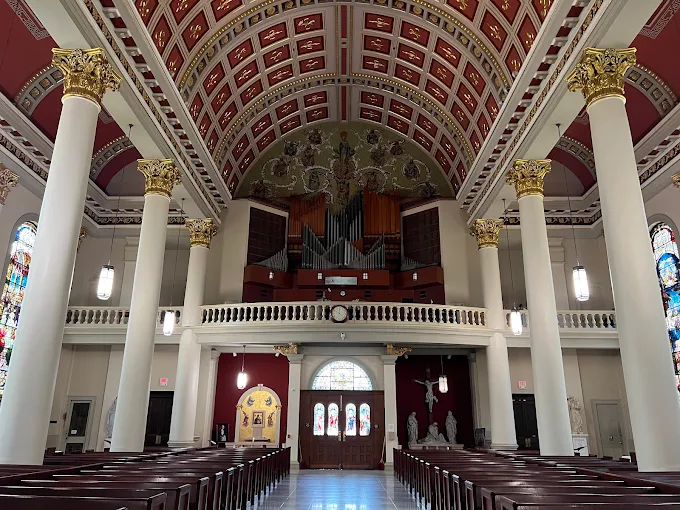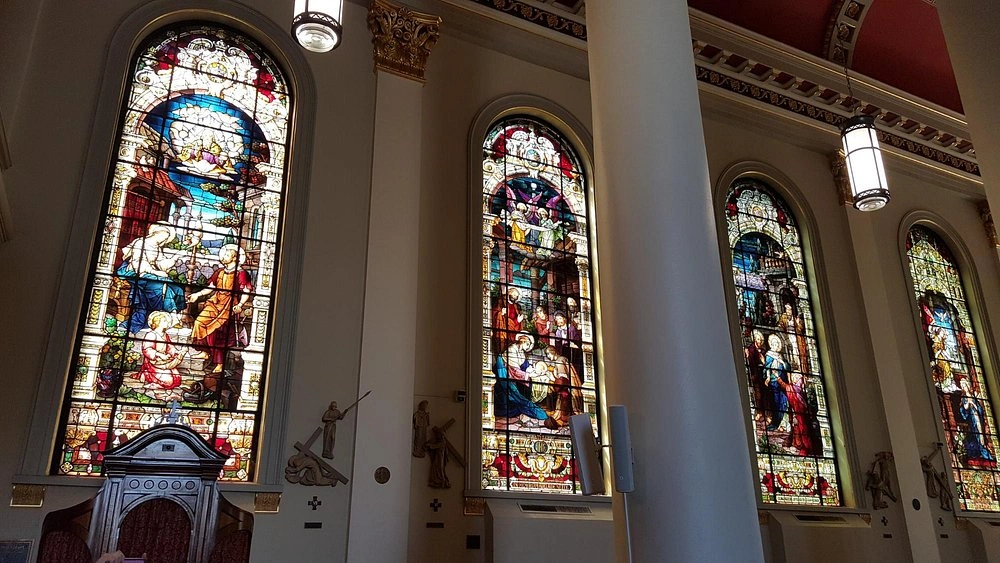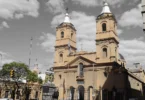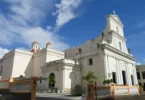Introduction

The Cathedral Basilica of the Immaculate Conception, known in French as Cathédrale de l’Immaculée-Conception de Mobile, is a historic Roman Catholic church located in downtown Mobile, Alabama. It serves as the mother church of the Archdiocese of Mobile and is the official seat of the Archbishop. Dedicated to Mary, the mother of Jesus, under the title Our Lady of the Immaculate Conception, the cathedral holds deep spiritual and cultural significance for Catholics in the region. It’s not only a place of worship but also a landmark of Mobile’s rich religious history. The cathedral is recognized on the National Register of Historic Places and continues to be an active part of the local faith community.

Early churches
Mobile’s Cathedral Parish was established on July 20, 1703, by Jean-Baptiste de la Croix de Chevrières de Saint-Vallier, Bishop of Quebec. Bishop de Saint-Vallier named Father Roulleaux de La Vente, first pastor of the parish church, which was located at the French settlement of Mobile at the citadel of Fort Louis de la Louisiane. The parish was established as the first on the Gulf Coast. A new parish church, Notre Dame de la Mobile (Our Lady of Mobile), was constructed when the Mobile settlement moved to its current location in 1711. In 1781, during the Spanish occupation of Mobile, the parish took its current name, Immaculate Conception. Pope Pius VIII erected the Diocese of Mobile in 1829 and appointed Bishop Michael Portier as its first bishop. The first “cathedral” built by Portier was a small wooden structure in the Old Spanish Burying Ground, which is now home to the cathedral. Portier soon set out to construct a “real” cathedral.
Construction and improvements
In 1833, Portier hired Claude Beroujon, a former seminarian turned architect to create a Roman basilica design for the new Immaculate Conception Cathedral. Portier laid the cornerstone of the cathedral in 1835. However, the financial crisis in the United States known as the Panic of 1837 forced a long delay in the cathedral construction. Portier finally consecrated Immaculate Conceptions in 1850. However, due to lack of funds, he was unable to construct the portico and towers. On May 25, 1865, at the end of the American Civil War, 30 tons of gunpowder ignited inside an ammunition depot operated by the Union Army in Mobile. The blast killed 300 people and destroyed much of the town. The windows and sashes on the north side of the empty cathedral were blown in by the explosion. Bishop John Quinlan was finally able in the 1870s to add a classical portico, with eight massive doric columns, to the outside of the cathedral. The two towers were completed in 1884 by Bishop Jeremiah O’Sullivan In 1946, a US Navy aviator hit the South Tower of the cathedral before crashing his plane and dying.
Fire damage and restoration
On March 19, 1954, a homeless man sheltering in the church basement caused a fire that raced up through the sanctuary. Two firefighters, both former altar boys, ran into the burning building to retrieve religious objects. The cathedral was saved from the blaze, but extensive fire, smoke, and water damage occurred inside. Eight of the large stained glass windows were destroyed, along with the cathedral, pulpit and pipe organ. The estimated damage, which was not covered by insurance, was $250,000. Bishop Thomas Toolen sent the stained glass windows that had been damaged in the fire in 1954 to the Munich workshops of Franz Meyer for repair. He added new mahogany chairs to the cathedra and pulpit. A replacement organ, built by the Wicks Organ Company of Highland, Illinois, was installed. Toolen also added a massive bronze baldachin above the altar, supported by four marble columns.

Recent modifications
In the 1970s, Bishop John L.May modified the sanctuary in compliance with the 1970 General Instruction of the Roman Missal issued by the Vatican. The Second Vatican Council’s changes to church layouts in the 1960s were outlined in this document. May moved the altar forward and removed the altar rails. The cathedra was moved to the south end of the sanctuary, facing the congregation. May also placed a large crucifix over the tabernacle and a bronze statue of the risen Christ above the baldachin. Hurricane Frederic damaged the cathedral steeples in 1979, forcing the parish to replace its wooden crosses with metal ones. In the 2000s, the most recent restoration effort was led by Archbishop Oscar Hugh Lipscomb. The cast-iron fence was restored and fixed, and the cathedral’s exterior was cleaned and fixed under his direction. A coffer ceiling was added to the interior by Conrad Schmitt Studios to cover the main aisle. The coffers are decorated with alternating gold-leafed fleur-de-lis and shamrock, symbolically representing the Trinity, as well as the contributions of the French and Irish religious to the life of the Archdiocese. New lighting and a new color scheme brightens the interior. White marble flooring was installed in the aisles and the heart pine floors under the pews were refinished. The coats of arms of the Mobile bishops and archbishops are embedded in the marble floor of the main aisle. A mural of the Tree of Jesse was installed above the pipe organ. Archbishop Lipscomb gives a picture of the Immaculate Conception to Pope John Paul II. A photograph of the cathedral was given to Pope John Paul II by Lipscomb in the year 2004. In 1962, Pope John XXIII elevated the cathedral to a minor basilica. The pope’s personal coat-of-arms is installed above the cathedral entrance. The yellow and red umbracullum (umbrella) and tintinnabulum (bell) in the sanctuary.
Location and dimensions
Mobile’s Immaculate Conception Cathedral can be found on South Claiborne Street. Dauphin Street to the north, Franklin Street to the west, and Conti Street to the south form its boundaries. The front of the church faces east, toward the Mobile River, and overlooks Cathedral Square. The cathedral is listed on the National Register of Historic Places as a contributing property to the Church Street East Historic District and the Lower Dauphin Street Historic District. It is part of the Historic Roman Catholic Properties in Mobile Multiple Property Submission The building, laid out in an east–west axis, is 164 ft (50 m) long and 90 ft (27 m) wide. The ceiling is 60 ft (18 m) at its highest point, and its twin towers rise to 103 ft (31 m).
Architecture of Cathedral Basilica of the Immaculate Conception, Mobile, Alabama, United States

Architect : Claude Beroujon.
Architectural style: Greek Revival architecture, Neoclassical architecture.
Bishop Portier entrusted the plans for the cathedral to a former seminarian turned architect, Claude Béroujon, who designed a Roman-style basilica. Construction began in 1835, but the Panic of 1837 delayed funding and work. It was not consecrated by Bishop Portier until 1850. The portico and twin towers were not completed until later. The hexastyle Doric portico was commissioned by Bishop John Quinlan (1826-1883), the second Bishop of Mobile, in the 1870s. The towers were added in 1884 under Bishop Jeremiah O’Sullivan. The building, which is oriented, measures 50 m in length, 27 m in width and 18 m in height. Its towers rise to 31 m.

Stained glass windows
The stained glass windows are the cathedral’s major artistic attraction. They were commissioned from the Munich firm Franz Mayer & Co and installed from 1890 until 1910, under the episcopate of Bishop Edward Patrick Allen. The twelve main stained-glass windows, six on the north wall and six on the south wall, are approximately 2.4 m wide and 7 m high and each depicts an episode in the life of the Virgin Mary in connection with her Son. Those on the south wall depict her Immaculate Conception, the Presentation of Jesus in the Temple, the Annunciation , the Visitation , the Nativity of Jesus and the Holy Family . Those on the north wall depict the Finding of Jesus in the Temple, the Wedding at Cana , the Crucifixion of Jesus , Pentecost , the Assumption , and the Coronation of the Virgin , Queen of Heaven. Two large stained-glass windows are located under the towers flanking the portico. One depicts the Baptism of Jesus to the north, and to the south the other depicts Saint Cecilia, patron saint of musicians. Smaller stained-glass windows are located behind the main entrance. They depict, from left to right, Saint Augustine, Our Lady of Mount Carmel , the Presentation of Mary in the Temple, Saint Louis, Saint Patrick , Our Lady of the Immaculate Conception, Saint Agnes , and the Sacred Heart . Above the four middle doors, you can admire the stained-glass window of the Holy Spirit.
Today
The cathedral was restored in 1954 (the stained glass windows were repaired in Munich by Franz Mayer & Co. , a bronze canopy was added above the high altar and the organ was replaced) and in the 2000s. The interior was redesigned in the 1970s in accordance with the new post-conciliar provisions: the communion table was removed and an altar facing the people was installed. The cathedral was elevated to the rank of minor basilica by John XXIII in 1962.
Feast Day
Feast Day : 8 December
The Cathedral Basilica of the Immaculate Conception in Mobile celebrates its feast day on December 8, honoring the Feast of the Immaculate Conception. This day celebrates the belief that Mary, the mother of Jesus, was conceived without original sin.
Church Mass Timing
Monday to Friday : 12:10 PM
Saturday : 8:00 AM , 4:30 PM
Sunday : 8:30 AM , 10:30 AM
Church Opening Time:
Monday to Sunday : Open 24 hours
Contact Info
Address : Cathedral-Basilica of the Immaculate Conception
2 S Claiborne St, Mobile, AL 36602, United States
Phone : +1 251-434-1565
Accommodations
Connectivities
Airway
Cathedral Basilica of the Immaculate Conception, Mobile, Alabama, United States, to Mobile Regional Airport, distance between 21 min (12.4 mi) via Airport Blvd.
Railway
Cathedral Basilica of the Immaculate Conception, Mobile, Alabama, United States, to South Claiborne Station, distance between 1 min (0.1 mi) via S Claiborne St.








